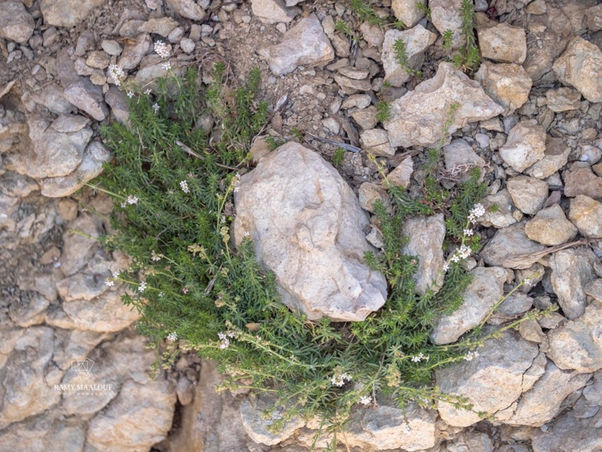Family |
Rubiaceae
Galium incanum
Sm.
Galium incanum Sm.
(in J. Sibthorp & J. E. Smith, Fl. Graec. Prodr. 1: 91; 1806 – Nouvelle Flore du Liban et de la Syrie, vol. 2, Pl. CLX nº 2; 1969)
• Life-form & habit: Multistemmed perennial herb, 15–30 cm tall, softly velvety-pubescent, becoming glabrescent or glabrous with age; stems angular, often numerous from the base.
• Leaves: In whorls of 6, linear, often very closely set on small plants, 10–25 mm long, blackening when dried, sometimes a little broader and somewhat shining when dry.
• Inflorescence & flowers: Flowers grouped in 3–7 at the axils of the upper leaves, usually exceeding them and forming a thyrsoid raceme; pedicels as long as the flower. Corolla relatively large, 3.5–4 mm, white, with lanceolate lobes, acute or shortly mucronate. Anthers dark. Style bifid.
• Fruit: Usually glabrous, occasionally sparsely hairy; mericarps globose.
• Phenology: Flowers in May–June.
• Habitat & elevation: Grows in high-altitude regions, chiefly on calcareous mountain slopes and rocky alpine pastures.
• Lebanese distribution:
Mount Lebanon — above Faraya; Barouk Cedars; Jabal Barouk; Jabal Kneissé; Jisr el-Hajar; Neba el-Laban; Laqlouq; Khan Sannine; Jabal Sannine; Jourd Hadeth; Tannourine; Hadeth Cedars; ʿAïn el-ʿAsafir; Sir ed-Dennié; Dimane; from Dimane to Yammouné; Hasroun; the Cedars Pass; ʿAïn el-Qarn; the Cedars; Bcharré; Foum el-Mizhab; Jabal Qamouʿa; Qornet es-Sawda; ʿAïnata; Mchaïtiyé-ʿAïnata.
Hermon — summit (collections Gaillardot, Kyrillos, Schlumberger et al.); also near Qalaʿat Jendel.
Anti-Lebanon — Bloudane, ʿAin Younoun, Yabrud, Maʿlula, Jabal Halimé, Signal de Zemrani, Talaʿat Moussa, Madaya.
Northern Latakia — summit of Jabal el-Cassius.
• Native to: East Aegean Is., Greece, Iran, Kriti, Lebanon-Syria, Palestine, Transcaucasus, Türkiye (POWO).
• ⚠️ Taxonomic note:
According to Mouterde (1969), Galium incanum is a Middle-Eastern mountain species previously subdivided by Ehrendorfer into subsp. libanoticum (Mount Lebanon) and subsp. antilibanoticum (Anti-Lebanon & Hermon), but his own examination of material from both ranges revealed no consistent differences. He also noted that the plant from Mount Hermon described by Boissier as G. schlumbergeri represents only a luxuriant form of G. incanum.









